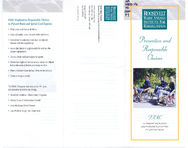PARC Emphasizes Responsible Choices to Prevent Brain and Spinal Cord Injuries:
Wear your seat belt at all times. Obey all traffic laws. Do not drink and drive. Do not move someone who may be injured;
instead call for expert help. Know the limits of a given activity and use the
proper equipment. Do not drink and participate in sports. Check the depth of the water and check for objects
below the surface before you jump or dive. Wear a helmet when riding a bike or motorcycle. Practice weapon safety.
The PARC Program was created in 1991 as a collaborative initiative involving:
Roosevelt Institute - Brain Injury Program Rotary Club of Meriwether County Juvenile Judge David Turner Late Probate Judge Idus Robertson
ROOSEVELT
WARM SPRINGS INSTITUTE FOR REHABILITATION
:J'tefIJenlr/vn an!
llespoTisitle
ChvfLces
An educational and interactive program designed to prevent brain
and spinal cord injuries
What is PARC?
PARC is a prevention program designed to provide education and experiences which reduce risky behaviors in adolescents between the ages of 14 and 19. The program consists of one session with a limited number of participants per session.
Participants are vehicle violation offenders identified by probate and juvenile judges through the traffic court system in Meriwether and surrounding Middle Georgia counties. Participants are involved in activities designed to bring awareness of the possible consequences of their behaviors and to encourage changes in knowledge, attitude and, ultimately, behavior.
Participation in the program is part of the sentence issued by the probate or juvenile judges in the traffic court system. Referrals are made by the judges. Participants are scheduled and provided with necessary information regarding location, fee and time.
Why is PARC Needed?
Motor vehicle accidents are the leading cause of brain and spinal cord injuries, with the highest rate occurring among adolescents. Adolescent risk-taking behavior account for these high rates of injury.
Traditional prevention measures have focused on changing harmful factors in the environment, but have failed to deal with adolescent risk-taking behaviors. The PARC Program emphasizes each individual's accountability to make responsible choices, thereby reducing risk-taking behaviors.
Is PARC Successful?
The PARC Program has served over 1,000 teens since it's inception in 1991. Aformal evaluation conducted under the direction of Emory University Rollins School of Public Health shows positive changes in attitudes, behaviors and knowledge.
Specific results of the evaluation indicate:
PARC has been well received by participants and referral sources.
Target population has been well served.
Changes occurred in behavior and attitude related to speeding.
Changes occurred in behavior and attitude related to diving.
Changes occurred in behavior and attitude related to helmet use.
Number of repeat offenses was reduced.
Rate of brain and spinal cord injuries decreased by 75% in the host county.
"Because of the severihJ of brain and spinal cord injuries, as well as their high long-ternl costs, it is important to find effective means of preventing their occurrence. The PARC Prograrn targets young persons who have been identified as being at the greatest risk of brain or spinal cord injuries because of their behavior. The results of this evaluation indicate promise for use of educational and experiential programs similar to PARC for adolescents as an effective strategy for reducing injuries caused by irresponsible risk behaviors."
- Rollins School of Public Health-Emory University
What Do PARC Participants Say?
100% felt participation in the program was beneficial to them.
85% report a change in their driving behavior. 93% report they shared information received
with friends. 96% recommended all high school students
attend PARe.
Brain Injury Program Roosevelt Warm Springs Institute for Rehabilitation 6391 Roosevelt Highway Post Office Box 1000 Warm Springs, Georgia 31830-0268 Phone 706.655.5297 Fax 706.655.5314 www.rooseveltrehab.org
